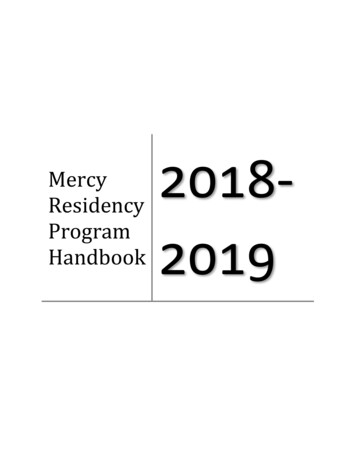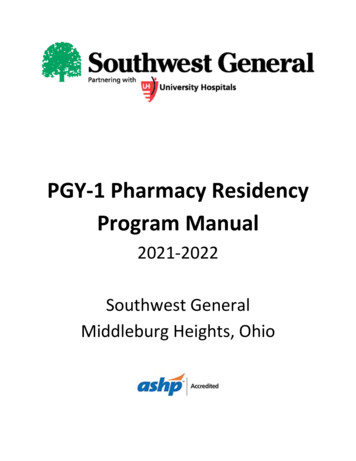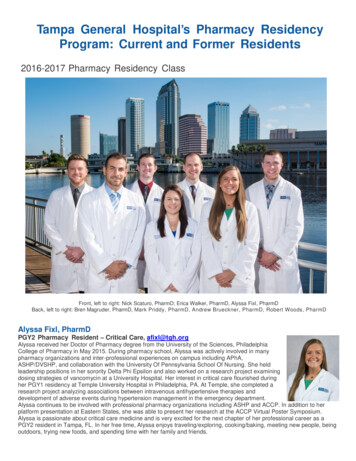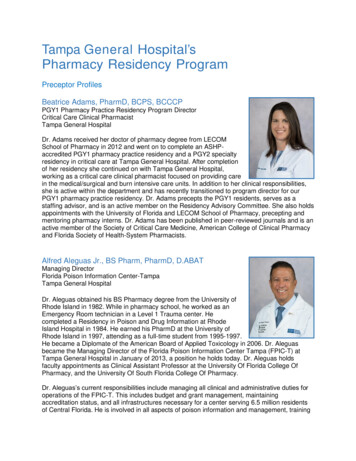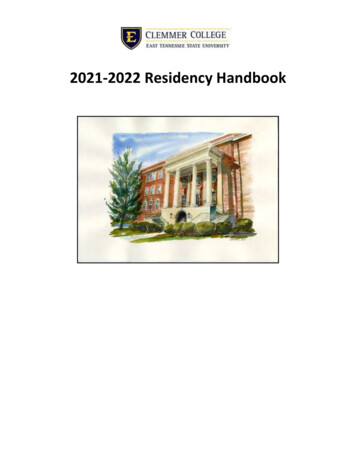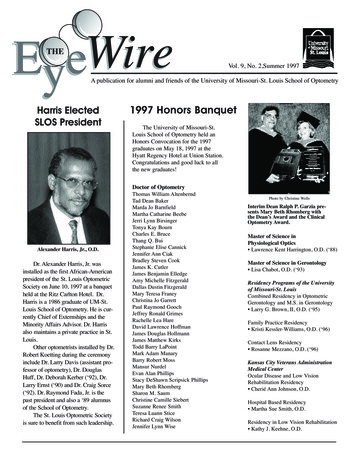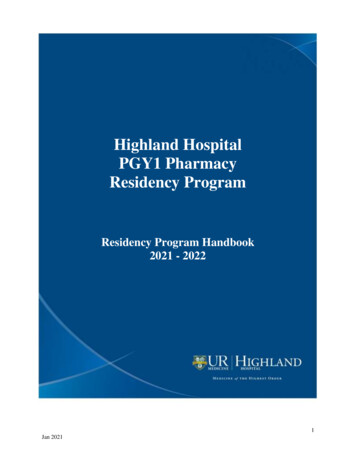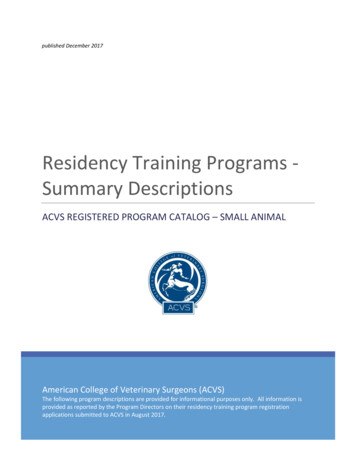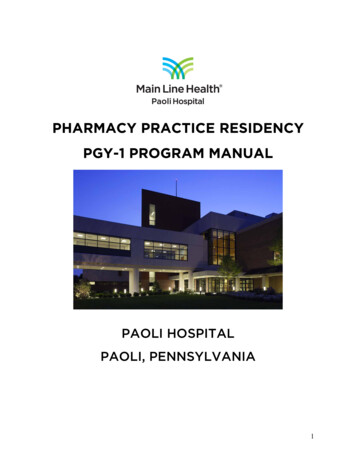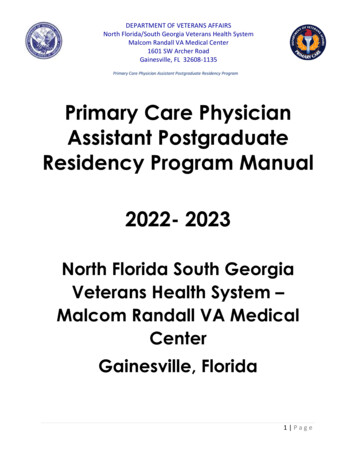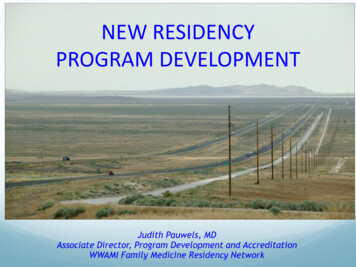
Transcription
NEW RESIDENCYPROGRAM DEVELOPMENTJudith Pauwels, MDAssociate Director, Program Development and AccreditationWWAMI Family Medicine Residency Network
Overview GME program models / training options Different specialties Critical conversations for communities developingresidency training opportunities Funding considerations: Starting the program Sustaining the program Common challenges
GME Training for Rural Needs Primary Care: Family Medicine General InternalMedicine General Pediatrics Specialty Care: Psychiatry General Surgery Obstetrics/Gynecology
GME Program Models “Full” training program: Independently accredited Minimum size: FM: 4 residents/year for 3 years IM: 5 residents/year for 3 years GS: 3 residents/year for 5 years Psych: 3 residents/year for 4 years Requires sufficient size of community andlocal health care institutions to supporttraining
GME Program Models Training track: Associated with a core program in a largercommunity Full time at rural location; more senior residents;usually 1-2 years 1-3 residents/year Rural rotation: Associated with a core program Typically 1-2 months at rural location; can belonger 1 resident at a time
Critical conversations:What does it take to “grow” a GME program? Program mission Sponsoring institution Community support Training resources Attractiveness toapplicants Financial viability
Program Mission: the “ROI” New providers forcommunity Meeting regionalworkforce needs Meeting local serviceneeds: community access Quality improvement Recruitment/retention ofother local physicians
Envisioning mission Training the future primarycare workforce Knows local institutions andphysicians Committed to and skilled inexcellent patient care Trained in systems-basedpractice, team-based care,leadership, and health systemsapproachesDr. Jim GuyerBillings MTDr. Ned VasquezMissoula, MT
Sponsoring Institution Sponsors: Hospital Community healthcenters Consortium For Rural Tracks androtations: Must be affiliatedwith a core program
Community support Local physicians to leadprogram Program/site director Program faculty Local hospitals/healthcare systems Specialty physicians Community engagementDick McLandress, MDCoeur D’Alene ID
An aside: UME/GME Undergraduatemedical education(medical students): Require moresupervision Can be used for fewerpayment opportunities Active learningoptimal but more of arole for “rolemodeling” Graduate medicaleducation (residents): Gradually increasingabilities, need for lesssupervision Can be used for morepayment opportunities: Documentation Procedural assistance Can be more active inteaching others and inleadership Critical to use Adult Learningmodels (action)
Teaching resources Patient volumes Inpatient Outpatient Diversity Procedures Staff support Space Electronic healthrecord Simulation labs Observation /videotapingcapabilities Conference rooms Communications Electronic resources
Family Medical Center Concept Location Existing patientpopulation Unmet communityneeds
Attractiveness to applicants Local/regional“pipeline” Current trainingprograms in region Match rates andquality What you willhave to offerTHEM
Attractiveness to applicants:if you build it, will they come? Factors helping: New medical schools and existing school expansions: morestudents in pipeline Factors hurting: Increased medical student debt Challenges facing rural health care delivery systems Rural training tracks: Develop local/regional pipeline Recruitment strategies Rural rotations Be sensitive to travel/family issues
Attractiveness to applicants:if you build it, will they come (and stay)? Family Medicine: WWAMI region typically higher US graduatematch rates than rest of country, and higher postgraduate retention rate locally Internal Medicine, General Surgery: Significant post-graduation fellowship rates Psychiatry: Challenge with filling with US graduates
What does it take to “grow” a program? Program mission Sponsoring institution Community support Family Medical Centerbase Attractiveness toapplicants Financial viability
Financial Planning Funding Projections - Revenues Funding Projections – ExpensesThree phases: Start-up Program build-up Mature program/ongoing operations
Funding Projections - Revenues Federal: CMS: DME/IME; CAH; other HRSA: Teaching Health Centers VA funding State: Medicaid: GME State budget lines Patient care services provided Hospital / Sponsoring Institution support Other (foundations, grants, etc.)
Funding: Rural training tracks Federal: CMS: SCH and CAH payments State Patient care services provided Hospital / Sponsoring Institution support Paying for the first years of training Ability of core program to “break even” FM 1 yr; psych 2 yr, gen surg 2 yr Complex CMS and accreditation rules
Funding: Rural rotations Federal: CMS: CAH State Patient care services provided Hospital / Sponsoring Institution support Paying for resident training Ability of core program to “break even” They may “lose” GME there Complex CMS and accreditation rules
Funding Projections - Expenses Facultycompensation andbenefits Resident salaries,benefits and support Program operationalstaff FMC costs Staff Fixed andoperationalexpenses Educational support Accreditation costs Insurances(malpractice) Faculty and residentrecruitmentRoughly 150,000/resident/year
Thinking about program financing: Finances are NOT why a community starts a program,nor the only factor in the decision to do so. However, they ARE a critical factor in determining theviability of developing and sustaining a successfulprogram. GME training is not cheap, and it depends upongovernment sources of funding to make it affordablefor communities.
Critical conversations What is the mission? To what extent are the needed resources (both nonfinancial and financial) available? To what extent are the key participants ready andwilling to commit? Opportunity to create the health system of the futurethat will effectively and efficiently produce the bestpatient outcomes, with providers who are thriving(the “Quadruple Aim”).
Challenge #1: funding CMS rules Caps “Zero” PRA CAH/SCH issues BIGGEST ISSUE FOR MOST PROGRAMS Medicaid funding State fundingOpportunities to address: New funding streams; Medicaid GME federal matches GME Initiative Group Many congressional bills in the pipeline State support inititatives
Challenge #2:faculty recruitment and retention Few physicians in a community may be interestedin teaching Faculty recruitment: Differential pay scales with community physicians May be MORE work than community colleagues Faculty development Teaching skills Faculty retention
Challenge #3: teaching resourcesAvailability of and competition for teaching resources,and limited sites that are able to support residenttraining programs: Size of hospital (beds, occupancy/utilization) Number of procedures done locally Ability of community to provide specialty servicesOpportunities to address: Can be sometimes mitigated through carefulplanning around interprofessional education models,and also using residents to teach medical students Training of community preceptors critical to theirsuccess and confidence as teachers
Timelines Sponsoring Institution Accreditation: about one year Planning a program: one-two years Program accreditation: one year Year prior, resident recruiting: one year And then the fun begins! First graduate 3-5 years later
Regional family medicine expansion New programs: SeaMar CHC Everett (6-6-6): 2017Richland/Kadlec (6-6-6): 2015Community Health Tacoma (6-6-6): 2014Coeur D’Alene, ID (6-6-6): 2014Missoula/Kalispell, MT (10-10-10): 2013East Pierce, Puyallup (6-6-6): 2012 Program THC expansions and RTTs: Boise, ID (THC)Spokane, WA (THC)Billings, MT (THC)Yakima/Ellensburg, WA (THC/RTT)Chehalis/Centralia, WA (RTT)
Regional family medicine potential AOA program “conversions”: Grandview, Kennewick, MountVernon, Puyallup Tribe, Health Point CHC Renton New programs: Harrison’s Medical Center, Bremerton ? others New Rural Training Tracks: Port Angeles Walla Walla Pullman Aberdeen Chelan Others
Psychiatry (4 years) Current: UW Seattle UW/Idaho “2 2” track: 2 yr Seattle, 2 yr Idaho, 3residents/year expanding to 4/yr UW rural rotations: Anchorage, Fairbanks, Billings) Fellowships: ACGME-accredited: Child/Adolescent; Addiction; Geriatric;Psychosomatic Non-accredited: Integrated Care (new, plan 5/year) Spokane: 3 residents/yr for 4 yr Potential?
Other specialties General surgery: UW Seattle Prior rural rotations not successful Other states: one-year rural rotation; small programs Pediatrics: CHMC Seattle Alaska rural track; rural rotations Obstetrics/gynecology: Rural rotations
NEW RESIDENCYPROGRAM DEVELOPMENTContact: jpauwels@uw.edu
GME Program Models "Full" training program: Independently accredited Minimum size: FM: 4 residents/year for 3 years IM: 5 residents/year for 3 years GS: 3 residents/year for 5 years Psych: 3 residents/year for 4 years Requires sufficient size of community and local health care institutions to support training
